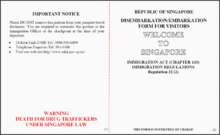Arrival card


An arrival card, also known as an incoming passenger card, landing card or disembarkation card, is a legal document used by immigration authorities of many countries to obtain information about incoming passenger not provided by the passenger's passport (such as health, criminal record, where they will be staying, purpose of the visit, etc.) and to provide a record of a person's entry into the country.[1][2][3][4] The card may also provide information on health and character requirements for non-citizens entering the country.[5] Some countries require an arrival card for each incoming passenger, while others require one card per family unit, and some only require an arrival card for non-citizens only.
Some countries, such as Singapore and Thailand, attach a departure card to the arrival card, which is retained in the alien's passport until their eventual departure. The arrival card can also be combined with a customs declaration, which some countries require incoming passengers to fill out separately.
Some countries, such as Malaysia,[6] do not require an arrival or departure card. The procedure of compiling information from immigration cards is no longer required by United States authorities following the introduction of the biometric recording system by the United States Customs and Border Protection.[3][7] There is minimal cross-border formality between a number of countries, most notably those in the passport-free travel area of Europe's Schengen Zone.[8] The US state of Hawaiʻi requires all visitors, even those on domestic flights, to fill out a card which is sent to the state's department of agriculture.[9]
The requirement to produce an arrival card is usually in addition to a requirement to produce a passport or other travel document, to obtain a visa, and sometimes complete a customs declaration.
Information on the card itself[]
The information requested varies by country. Typically the information requested on the arrival card includes:
- Full name
- Nationality
- Date of birth
- Passport number, place of issuance and expiration date
- Flight number or name of aircraft, ship or vehicle
- Purpose of trip: vacation, education/study, visiting relatives/families, business, diplomatic
- Duration of stay
- Destination (next stop of disembarkation)
- Address in country
- Information on items being bought into the country which may be of interest to customs and quarantine authorities
Travellers are generally required to sign, date, and declare the information is true, correct, and complete.
United Kingdom[]
Non-EEA citizens were formerly required to complete a landing card on entry to the United Kingdom. The traveller was required to present the completed form at the Border Force desk at the point of entry. The form was usually supplied by the airline, train or ferry company.[10]
In the UK, the landing card system was governed by the Immigration Act 1971, schedule 2 paragraph 5, which states;[11]
The Secretary of State may by order made by statutory instrument make provision for requiring passengers disembarking or embarking in the United Kingdom, or any class of such passengers, to produce to an immigration officer, if so required, landing or embarkation cards in such form as the Secretary of State may direct, and for requiring the owners or agents of ships and aircraft to supply such cards to those passengers.
In August 2017, the UK Home Office announced that landing cards will be completely scrapped as part of digital border transformation and modernisation. It was expected this change would come into effect by the autumn.[15] Landing cards were abolished for all passengers effective 20 May 2019.[16]
Notably absent from the landing card was information on the purpose of the trip, destination, or any items brought into the country. Additional information requested from travellers was their occupation and the port of their last departure.[17][18][19]

See also[]
References[]
- ^ Passenger Cards. Department of Immigration and Citizenship. Australian Government.
- ^ cbp.gov, What to Declare Archived 2016-09-15 at the Wayback Machine
- ^ a b "U.S. Customs and Border Protection Declaration Form 6059B, CBP Issues New Customs Declarations Form, Features Expanded Definition of Family Members". Archived from the original on 2016-09-15. Retrieved 2016-08-31.
- ^ NZIS431 - New Zealand Passenger Departure Card Archived 2008-10-15 at the Wayback Machine. Statistics New Zealand.
- ^ NZIS431 - New Zealand Passenger Departure Card. Statistics New Zealand.
- ^ Malaysia no longer require immigration cards
- ^ cbp.gov, US Citizens
- ^ per Article 21 of the Schengen Borders Code (OJ L 105, 13 April 2006, p. 1).
- ^ WAGNER, KATHRYN DRURY (21 May 2008). "Well, I Declare". Honolulu Magazine. aio Media Group. Retrieved 7 December 2019.
- ^ UK, gov.uk, Entering the UK
- ^ International scholarship guide, 7 Things to do before your planes lands and once you alight at a UK International Airport
- ^ Children & Immigration By Jeremy Rosenblatt, Ian Lewis, page 88
- ^ Immigration Law Handbook, 2013, By Margaret Phelan, James Gillespie, page 50
- ^ parliament.uk, Nationality, Immigration and Asylum Bill, 172.6
- ^ Outdated landing cards to be withdrawn as part of digital border transformation
- ^ "UK to scrap passenger landing cards". BBC News. 16 May 2019. Retrieved 16 May 2019.
- ^ UK Landing Card, pic
- ^ UK Landing Card, pic
- ^ go2london.co.uk, Do you need a Visa to go to London?
- Civil aviation
- Identity documents